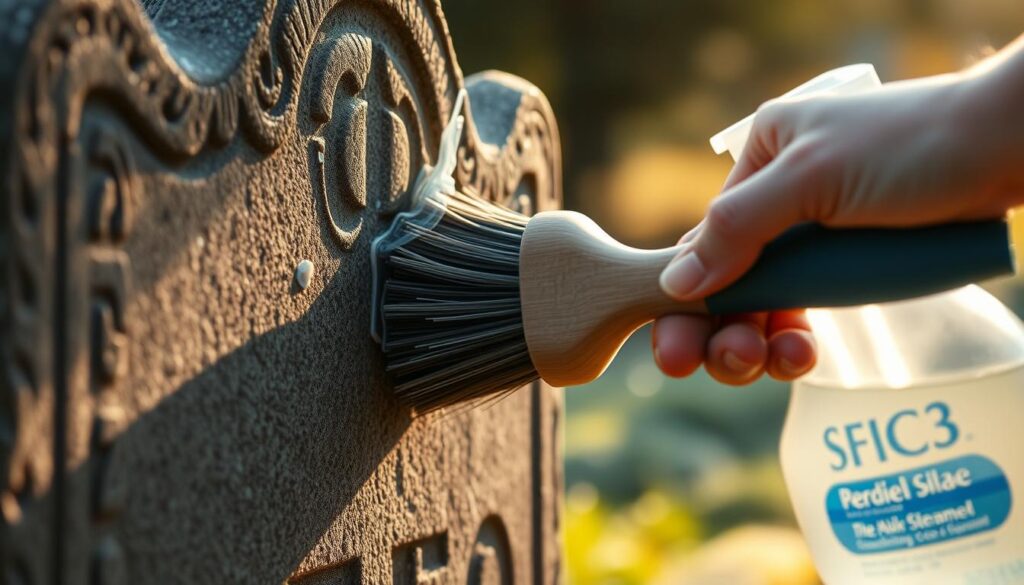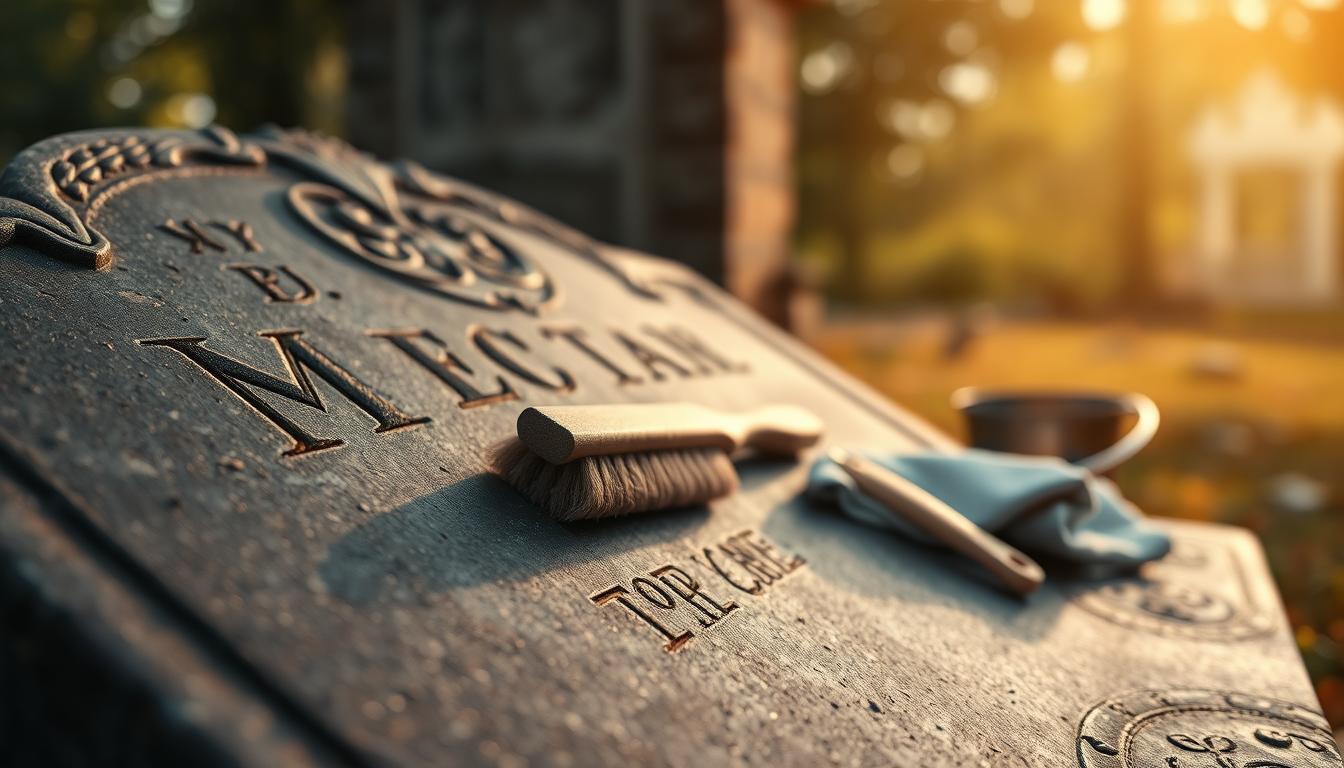Over 23 million Americans visit a cemetery every year, paying their respects to loved ones who have passed away. However, many of these historical memorials are in disrepair, with grave markers bearing the brunt of weathering and neglect.
As an expert in cemetery maintenance, I have seen firsthand the importance of preserving these memorials. Properly restoring grave markers not only honors the deceased but also helps to maintain the dignity of the cemetery as a whole.
In this guide, I will walk you through the correct process for cleaning grave markers, providing you with the knowledge and skills necessary to preserve these historical memorials for generations to come.
Key Takeaways
- Understand the importance of preserving historical memorials
- Learn the correct process for cleaning grave markers
- Discover the significance of cemetery maintenance
- Identify the steps necessary for grave marker restoration
- Gain the knowledge to preserve memorials for future generations
The Significance of Cemetery Preservation
Cemetery preservation is a vital aspect of maintaining historical records and paying respect to those who have passed away. According to the National Trust for Historic Preservation, cemetery preservation is crucial for maintaining the integrity of historical sites and honoring the deceased.
Cemeteries are not just places of reverence; they are also historical records that provide valuable insights into the past. Grave markers, in particular, serve as tangible connections to our ancestors, offering a glimpse into their lives, struggles, and achievements. However, these markers are susceptible to deterioration over time due to natural elements and human factors.
Why Grave Markers Deteriorate Over Time
Grave markers deteriorate over time due to exposure to natural elements such as weathering, acid rain, and extreme temperatures. Human factors, including vandalism, neglect, and improper cleaning methods, also contribute to the deterioration of grave markers. As a result, it is essential to understand the causes of deterioration to develop effective preservation strategies.
Honoring the Deceased Through Proper Maintenance
Proper maintenance of grave markers is a sign of respect for the deceased and their families. By preserving grave markers, we can ensure that the memories of our ancestors are not lost to time. Regular cleaning and maintenance can help to prevent deterioration and extend the lifespan of grave markers. This not only honors the deceased but also preserves the historical significance of the cemetery.
Understanding Different Types of Grave Markers
Different types of grave markers are used to commemorate the deceased, and understanding these differences is crucial for proper care. Grave markers can be made from a variety of materials, each with its unique characteristics and challenges.
Stone Markers: Granite, Marble, and Limestone
Stone markers are one of the most common types of grave markers. Granite is a popular choice due to its durability and resistance to weathering. Marble, on the other hand, is more prone to weathering and can be more challenging to clean and maintain. Limestone is another type of stone marker that requires careful maintenance to prevent damage.
Metal Markers: Bronze, Iron, and Zinc
Metal markers are also widely used in cemeteries. Bronze is a popular choice for grave markers due to its durability and resistance to corrosion. Iron and zinc markers are also used, but they require more maintenance than bronze markers to prevent rust and corrosion.
Other Materials: Wood, Concrete, and Glass
In addition to stone and metal markers, other materials are used for grave markers, including wood, concrete, and glass. These materials can be more fragile and require special care when cleaning and maintaining. Understanding the characteristics of these materials is essential for determining the best cleaning and maintenance techniques.
Essential Tools and Materials for Cleaning Grave Markers
Cleaning grave markers requires a thoughtful approach, starting with the selection of appropriate cleaning supplies. The National Park Service recommends using gentle cleaning methods and materials to preserve historical monuments, a principle that applies equally to grave markers.
Non-Abrasive Cleaning Supplies
The choice of cleaning supplies is critical to avoid damaging the grave marker. Non-abrasive cleaners are essential to prevent scratching or wearing down the surface. These cleaners should be specifically designed for the type of material the grave marker is made of.
Recommended Cleaning Solutions
For most grave markers, a mild detergent or a specialized stone cleaner is recommended. These solutions are gentle on the surface while effectively removing dirt and grime.
What to Avoid: Harmful Chemicals
Avoid using harsh chemicals or abrasive cleaners that can damage the grave marker. Avoid bleach and acid-based cleaners, as they can cause irreversible damage to certain materials.
Appropriate Brushes and Applicators
The right brushes and applicators are crucial for effectively cleaning grave markers without causing damage. Soft-bristled brushes are ideal for gently sweeping away debris, while applicators can be used to apply cleaning solutions directly to the marker.
Water Sources and Containers
Access to clean water is necessary for cleaning grave markers. Use a clean container to mix and apply the cleaning solution, ensuring that the water is free from contaminants that could damage the marker.
| Material | Recommended Cleaner | Avoid |
|---|---|---|
| Granite | Mild detergent | Acid-based cleaners |
| Marble | Specialized stone cleaner | Bleach, acid-based cleaners |
| Bronze | Mild soap solution | Abrasive cleaners, bleach |
Preparation Steps Before You Begin
Cleaning a grave marker requires more than just the right cleaning supplies. It demands a thorough understanding of the necessary preparation steps to ensure the task is done effectively and safely. Before you start cleaning, you need to be aware of the rules and regulations governing the cemetery, as well as the condition of the marker itself.
Obtaining Permission and Researching Cemetery Rules
First and foremost, it’s essential to obtain permission to clean the grave marker, if required by the cemetery administration. Researching cemetery rules is also crucial, as some cemeteries have specific guidelines for cleaning and maintaining grave markers. This may include restrictions on the types of cleaning products or methods used. By understanding these rules, you can avoid any potential issues or damage to the marker.
Documenting the Marker’s Condition
Documenting the condition of the grave marker before cleaning is vital for several reasons. It helps in identifying any existing damage or deterioration, which can be useful for insurance or restoration purposes. There are two key aspects to documenting the marker’s condition: photography and notes on damage and fragility.
Photography Before Cleaning
Take clear, well-lit photographs of the grave marker from multiple angles before you start cleaning. This visual record will help you track any changes or damage that may occur during the cleaning process.
Notes on Damage and Fragility
In addition to photographs, make detailed notes about the marker’s condition, including any cracks, broken parts, or signs of wear. This information will help you tailor your cleaning approach to the marker’s specific needs and avoid causing further damage.
| Preparation Step | Description |
|---|---|
| Obtain Permission | Check with cemetery administration for required permissions |
| Research Cemetery Rules | Understand guidelines for cleaning and maintenance |
| Document Condition | Take photographs and notes on the marker’s state |

The Complete Process of Cleaning Grave Markers
A well-executed cleaning process is vital for maintaining the integrity of grave markers. Cleaning grave markers requires a gentle and tested approach to avoid causing unintended damage. The process involves several key steps that must be followed carefully to ensure the marker is cleaned effectively without compromising its condition.
Initial Assessment and Testing
Before starting the cleaning process, it’s essential to conduct an initial assessment of the grave marker’s condition. This involves examining the marker for any signs of damage, deterioration, or previous restoration attempts. I also test a small, inconspicuous area to determine the best cleaning method and to ensure that the chosen cleaning solution does not damage the material.
Step-by-Step Cleaning Procedure
The step-by-step cleaning procedure involves several key steps. First, I remove any debris or loose dirt from the marker using a soft-bristled brush or a gentle blower. Next, I apply a suitable cleaning solution to the marker, taking care to avoid using harsh chemicals or abrasive materials that could damage the surface. The cleaning solution is then gently scrubbed into the marker using a soft-bristled brush, working from the top down to prevent dirt and grime from being redeposited onto clean areas.
| Cleaning Step | Description | Tools/Materials |
|---|---|---|
| 1. Debris Removal | Remove loose dirt and debris | Soft-bristled brush or gentle blower |
| 2. Cleaning Solution Application | Apply cleaning solution to the marker | Suitable cleaning solution |
| 3. Gentle Scrubbing | Gently scrub the marker | Soft-bristled brush |
Drying and Final Inspection
After completing the cleaning process, I allow the marker to air dry or use a soft, lint-free cloth to gently dry it. A final inspection is then conducted to ensure that the marker is clean and free of any remaining dirt or grime. This step is crucial in verifying that the cleaning process has been effective and that the marker is now in a satisfactory condition.
Specific Techniques for Stone Markers
The art of cleaning stone markers lies in understanding the unique characteristics of each stone type. Different stones have distinct properties that require tailored cleaning approaches. For instance, marble and limestone are more susceptible to acid rain and require gentle cleaning methods.

Marble and Limestone Care
Marble and limestone markers demand special attention due to their soft nature and susceptibility to weathering. When cleaning these markers, it’s essential to avoid harsh chemicals and abrasive materials that can damage the stone.
Dealing with Lichen and Moss
Lichen and moss growth on marble and limestone markers can be challenging to remove. A gentle cleaning solution, such as a mixture of water and a non-ionic detergent, can be effective in removing these unwanted growths.
Addressing Stains and Discoloration
Stains and discoloration on marble and limestone markers can be addressed using a poultice made from a cleaning solution and a absorbent material. This method can help draw out the stain, restoring the marker’s original appearance.
Granite Maintenance
Granite markers, being more durable than marble and limestone, still require regular maintenance to preserve their condition. A mild detergent and water can be used to clean granite markers, followed by a thorough rinse to remove any dirt or debris.
Sandstone and Slate Considerations
Sandstone and slate markers have unique characteristics that require specific cleaning approaches. Sandstone, being a softer stone, may require a gentler cleaning solution, while slate, being denser, can withstand slightly more aggressive cleaning methods.
In conclusion, cleaning stone markers requires a deep understanding of the stone type and its unique characteristics. By using the right cleaning techniques and materials, we can preserve these markers for future generations.
Proper Methods for Metal Grave Markers
Metal grave markers, such as those made from bronze, iron, or zinc, require specific care to maintain their integrity. As I delve into the best practices for restoring these markers, it’s essential to consider the unique characteristics of each material.
Bronze Marker Restoration
Bronze markers are known for their durability and resistance to corrosion. However, they still require regular maintenance to preserve their appearance. When restoring a bronze marker, I consider the patina, a layer that forms on the surface over time.
Removing Patina vs. Preserving It
The decision to remove or preserve the patina depends on the marker’s condition and historical significance. In some cases, removing the patina can damage the marker, so it’s crucial to weigh the pros and cons before making a decision.
Applying Protective Coatings
Applying a protective coating can help prevent further deterioration and corrosion. I recommend using a wax or lacquer coating, as these can provide a barrier against environmental factors.
Iron and Zinc Marker Care
Iron and zinc markers require different care techniques compared to bronze. Iron markers are prone to rust, so it’s essential to keep them dry and apply a rust-inhibiting coating. Zinc markers, on the other hand, can be cleaned with mild soap and water.
| Material | Cleaning Method | Protective Coating |
|---|---|---|
| Bronze | Mild soap and water | Wax or lacquer |
| Iron | Dry cleaning | Rust-inhibiting coating |
| Zinc | Mild soap and water | Wax or clear coat |
In conclusion, restoring metal grave markers requires a thoughtful and nuanced approach. By understanding the unique characteristics of each material and applying the right techniques, we can preserve these markers for generations to come.
Special Considerations for Aged and Fragile Markers
Cleaning aged and fragile grave markers demands a thoughtful and meticulous approach. As I delve into the specifics of preserving these historical markers, it’s essential to understand the unique challenges they pose.
Aged and fragile grave markers are more susceptible to damage, and their deterioration can be accelerated by improper cleaning techniques. Therefore, it’s crucial to identify at-risk markers and employ gentle cleaning methods to preserve their integrity.
Identifying At-Risk Markers
To identify at-risk markers, I look for signs of wear and tear, such as cracks, fading, or discoloration. Markers made from certain materials, like limestone or sandstone, are more prone to deterioration and require extra care. By recognizing these vulnerabilities, I can tailor my cleaning approach to minimize potential damage.
Gentle Techniques for Vulnerable Stones
When cleaning aged and fragile markers, I use gentle techniques that avoid harsh chemicals and abrasive materials. A soft-bristled brush and a mild cleaning solution are often the best tools for the task. For example, a mixture of water and a small amount of mild detergent can be effective for cleaning granite markers. By adopting a gentle approach, I can preserve the marker’s condition and prevent further deterioration.
When to Consult a Professional Conservator
While many grave markers can be cleaned with basic techniques, some require the expertise of a professional conservator. If a marker is extremely fragile or shows signs of significant deterioration, it’s best to seek professional help. A conservator can provide guidance on the best course of treatment and perform the necessary work to preserve the marker’s integrity. As stated by a renowned conservator, “The goal of conservation is to preserve the cultural and historical significance of the marker, not just its physical appearance.” By knowing when to consult a professional, I can ensure that aged and fragile markers receive the care they need.
| Marker Type | Cleaning Method | Precautions |
|---|---|---|
| Granite | Mild detergent and water | Avoid harsh chemicals |
| Limestone | Soft-bristled brush and gentle cleaning solution | Avoid abrasive materials |
| Sandstone | Gentle cleaning solution and soft cloth | Avoid excessive water |
Common Mistakes to Avoid When Cleaning Grave Markers
When it comes to cleaning grave markers, it’s essential to avoid common mistakes that can cause irreversible damage. Grave markers are a significant part of our cultural heritage, and improper cleaning techniques can lead to their deterioration. In this section, we will discuss the most common mistakes to avoid when cleaning grave markers.
Harmful Cleaning Agents and Methods
Using harsh chemicals or abrasive tools can damage grave markers. Some cleaning agents, such as bleach and household cleaners, can be particularly harmful. Bleach, for instance, can react with the stone or metal, causing discoloration or erosion.
The Dangers of Bleach and Household Cleaners
Bleach and household cleaners are not suitable for cleaning grave markers. These harsh chemicals can damage the surface, cause discoloration, or even lead to the deterioration of the marker. Instead, opt for gentle cleaning agents that are specifically designed for the type of marker you are cleaning.
Why Shaving Cream and Chalk Are Problematic
Some individuals may suggest using shaving cream or chalk to clean grave markers, but these methods are not recommended. Shaving cream can leave residue on the marker, while chalk can be abrasive and cause scratches. It’s crucial to avoid such unproven and potentially damaging techniques.
Pressure Washing and Abrasive Tools
Pressure washing and using abrasive tools are other common mistakes to avoid when cleaning grave markers. Pressure washing can dislodge particles, cause erosion, or even break the marker. Similarly, using abrasive tools, such as wire brushes or scouring pads, can scratch or damage the surface. Instead, use soft-bristled brushes and gentle cleaning techniques to preserve the integrity of the marker.
| Cleaning Method | Potential Damage | Recommended Alternative |
|---|---|---|
| Bleach and Household Cleaners | Discoloration, Erosion | Gentle Cleaning Agents |
| Shaving Cream and Chalk | Residue, Scratches | Soft-Bristled Brushes |
| Pressure Washing | Erosion, Breakage | Gentle Cleaning Techniques |
| Abrasive Tools | Scratches, Damage | Soft-Bristled Brushes |
By avoiding common mistakes and using gentle cleaning techniques, you can help preserve the integrity of grave markers for future generations. Remember, the goal of cleaning grave markers is not only to remove dirt and grime but also to preserve the historical and cultural significance of these monuments.
Seasonal Maintenance and Follow-Up Care
By adjusting maintenance practices according to the seasons, we can significantly extend the lifespan of grave markers. Regular seasonal maintenance is key to preserving the condition and integrity of these markers.
Different seasons bring different challenges for grave markers. In the spring and summer, markers are exposed to increased vegetation and potential damage from lawn care equipment.
Spring and Summer Maintenance
During the spring and summer months, it’s essential to inspect grave markers for damage caused by winter weather and to clean them as vegetation grows around them. Regular cleaning and inspection can help prevent long-term damage.
Fall and Winter Protection
In the fall and winter, grave markers require protection from harsh weather conditions, such as snow, ice, and freezing temperatures. Applying a protective coating or covering the marker can help shield it from damage.
Creating a Maintenance Schedule
To ensure consistent care, creating a maintenance schedule is crucial. By setting reminders for regular inspections and cleaning, we can stay on top of grave marker maintenance and prevent deterioration over time.
By following a seasonal maintenance routine and adapting to the changing needs of grave markers, we can preserve these important historical and personal markers for generations to come.
Conclusion: Preserving Our Heritage Through Respectful Care
As we conclude our guide to properly cleaning grave markers, it’s essential to recognize the significance of preserving our heritage through respectful care. Grave markers are not just historical records; they are also a way to show respect for those who have passed away. By properly maintaining these markers, we can ensure that the stories and memories of our loved ones are preserved for future generations.
Proper cleaning and maintenance play a crucial role in this process. By using the right techniques and materials, we can prevent damage to the markers and preserve their integrity. This not only honors the deceased but also helps to maintain the overall appearance and historical significance of the cemetery.
As we strive to preserve our heritage, we must do so with respectful care. This means being mindful of the materials and techniques used, as well as the potential impact on the markers and the cemetery as a whole. By doing so, we can ensure that grave markers continue to serve as a meaningful connection to our past, while also respecting the memories of those who have come before us.
FAQ
What is the importance of cleaning grave markers?
Cleaning grave markers is crucial for preserving historical records and honoring those who have passed away. It helps maintain the dignity and respect of the deceased and their families.
How often should grave markers be cleaned?
The frequency of cleaning grave markers depends on various factors, including the material, weather conditions, and cemetery rules. Generally, a gentle cleaning once a year is recommended, but it’s essential to check local regulations and assess the marker’s condition before cleaning.
What cleaning solutions are safe for grave markers?
The choice of cleaning solution depends on the type of material. For example, mild soap and water are often suitable for granite and bronze markers, while marble and limestone require more gentle and specific cleaning products. It’s best to avoid harsh chemicals and abrasive cleaners.
Can I use bleach or household cleaners on grave markers?
No, bleach and household cleaners are too harsh and can damage grave markers. They can cause discoloration, erosion, or other forms of deterioration, and are generally not recommended.
How do I remove lichen and moss from stone markers?
Removing lichen and moss from stone markers requires gentle techniques and specific cleaning solutions. A soft-bristled brush and a mild cleaning product can be used, but it’s essential to test a small area first to avoid damaging the stone.
What are the best practices for maintaining metal grave markers?
For metal grave markers, such as bronze, iron, or zinc, it’s essential to avoid using harsh chemicals or abrasive cleaners. Instead, use gentle cleaning products and soft cloths to preserve the patina and prevent corrosion.
How can I protect grave markers from seasonal damage?
To protect grave markers from seasonal damage, it’s recommended to inspect and clean them regularly, apply protective coatings when necessary, and take steps to prevent erosion and weathering. Creating a maintenance schedule can help ensure the long-term preservation of the markers.




